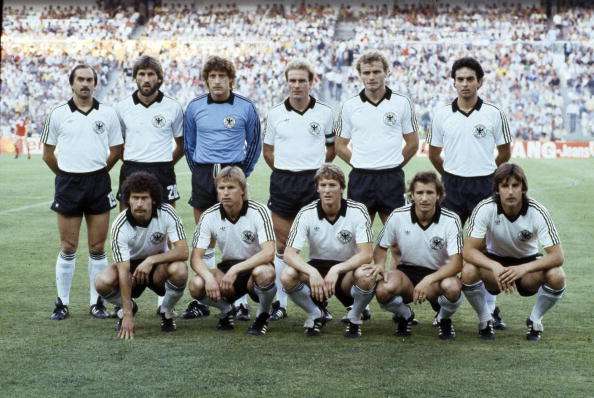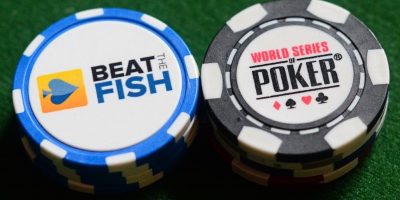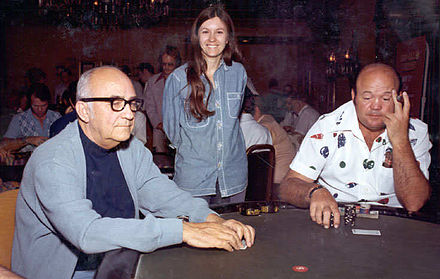The World Series of Poker is still Happening! Play the world’s Most Authentic Poker App! Join millions of players in the official World Series of Poker game! The most prestigious poker brand raises the stakes with THE authentic poker experience. Compete to win the ultimate prize in poker; your very own WSOP Bracelet! 1982 WSOP In 1982 the term “Chip and a chair” was coined. Jack Straus, who bore the nickname of “Treetop” due to his six and a half feet, had lost what he thought to be his entire stack and was getting up to leave when he discovered one $500 chip under a napkin.
The main event established itself as the focal point of the World Series of Poker in 1971. When Jack Binion created the WSOP, no one, including himself, could have ever imagined the explosive growth and its mainstream moniker as 'The Main.' Binion recently exclaimed, 'I'm amazed at how big poker got, especially the WSOP main event.'
Wsop online, free Poker
From its humble beginnings at Binion's Horseshoe in Downtown Las Vegas to its present home at the Rio All-Suite Hotel and Casino near the Las Vegas Strip, the WSOP main event has captured the imagination of poker players all around the world, while its champions have garnered legendary status.
As the 50th annual WSOP's main event begins, here are the top 15 victories with respect to significance and importance that have helped mold the event into the behemoth it is today.
After last year's second-largest registration (7,874 players; the record is 8,773 in 2006), could we possibly see a new mark set in 2019? We will find out by the end of the week.
Until then, here are my top 15 WSOP main event victories:

15. 2016: 'Who win? Qui Nguyen!'
Ever since 2008, when 22-year-old Peter Eastgate broke Phil Hellmuth's record for the youngest WSOP main event champion, the victor had been aged in the 20s. The young Internet wizards dominated the felt, and poker seemed to be slipping past the 'older' generation. However, in 2016, an unknown Vietnamese immigrant who came to the United States in 2001 at age 24, utilized an unconventional style in play and dress that captivated the poker world.

With every pot that the 39-year-old raked, his fans on the rail chanted 'Who win? Qui Nguyen!' Throughout his memorable run, few in the poker media predicted Nguyen could win. However, he proved the pundits wrong. Nguyen will always be remembered for his unexpected victory and the pure joy of his triumph.
14. 1972: Amarillo Slim
Although the WSOP main event was in its infancy, the top eight players came together to play in 1972. In the end, Thomas Preston, better known to the world as Amarillo Slim, prevented Johnny Moss from winning three in a row and suddenly became the first face of poker. Amarillo Slim, who used his poker moniker on television, was a frequent visitor on talk shows, including 'The Tonight Show,' hosted by Johnny Carson. Making more than 10 appearances on the iconic late-night program, Preston helped introduce poker to mainstream America and created public awareness of the WSOP.
13. 2006: Everything Jamie touched turned to gold
In the largest WSOP main event field in history (8,773 players), one would believe the tournament lead would jump around among numerous players. However, on Day 4, entertainment producer and agent Jamie Gold took over the chip lead and literally never looked back. Gold's dominating performance earned him a record $12 million for his victory.
12. 2004: Players become extinct via 'Fossilman'
The year after Chris Moneymaker shocked the world, Binion's Horseshoe was overflowing with players, with tables placed throughout the casino. The field was so big that there were issues with the fire marshal and players were forced to play 11-handed at times. However, one player emerged from the 2,576-player field sporting hologram sunglasses and protecting his cards with a fossil: Greg Raymer. While 1996 WSOP main event champion Dan Harrington made back-to-back final tables in the two biggest fields to date, the patent attorney from Connecticut led the final table from wire to wire, eliminating the upstart David Williams heads-up. This would be the last time the Horseshoe would hold the entire WSOP main event.
11. 2009: Youngest champion ever
The year prior, Peter Eastgate broke Phil Hellmuth's 19-year-old record as the youngest WSOP main event champion. The mark didn't last long, as 21-year-old Joe Cada broke it the following year. With the November Nine in full swing, the 2009 WSOP main event final table was jam-packed with notable players, including poker superstar Phil Ivey, Cardplayer editor Jeff Shulman and two young Europeans who also made the final table at the WSOP Europe main event in Antoine Saout and James Akenhead.
After being down to four big blinds -- and then hitting some timely sets against his opponents -- Cada played heads-up against an amateur logger from Maryland. Darvin Moon, who was the chip leader heading into the final table, had been the fairy tale of the 2009 WSOP main event. However, after a lengthy and competitive heads-up battle, Cada came out victorious, earning more than $8.5 million.

10. 1998: 'You call, it's gonna be all over, baby.'
Delivering one of the most famous poker quotes, 35-year old Scotty Nguyen exclaimed, 'You call, it's gonna be all over, baby,' to Kevin McBride during the final hand with a full house (9-9-8-8-8) on the board. While puffing on a cigarette and drinking his signature beer, Nguyen boldly broadcast the cocky remark, and McBride called, playing just the board. Nguyen revealed J-9 for a bigger full house to become the 1998 WSOP main event champion, and the Prince of Poker was born.
In total, Nguyen has five bracelets, including his most recent 2008 Poker Players Championship. However, his most disappointing WSOP appearance had to be in 2007, when he blew up versus Philip Hilm while on the verge of another WSOP main event final table. That time, Nguyen's braggadocio got the better of him.
9. 1993: First satellite champion
Eric Drache, the WSOP tournament director from 1973 to 1988, created the concept of the satellite to increase the number of participants in the main event. In 1983, the field size of the main event was only around 100 players. Thus, for every player that could satellite into the main event, the field size would increase by a percentage point.
The awareness of these satellites also grew in 1983, when Doyle Brunson was eliminated in third place. Both remaining players, Tom McEvoy and Rod Peate, had won a 1983 WSOP main event seat via satellite. After a long heads-up battle, McEvoy became the first WSOP main event champion to win the bracelet after gaining entry via satellite.
Today, the WSOP main event is primarily fueled by satellite winners, with the most famous one coming in 2003.
8. 2012: Double-double WSOP winner
Entering the WSOP main event, Phil Hellmuth, who had finished second in the WSOP Player of the Year standings in 2006 and 2011, was leading the 2012 WSOP POY race and was all but assured of adding another line on his illustrious résumé. The only scenario that would prevent Hellmuth from achieving his long-awaited goal was a Greg Merson victory in the main event.
After a relatively quick Day 1 of the 2012 WSOP main event final table, the final three players returned with an average stack of 110 big blinds. Thus, many presumed a long Day 2. But no one could have anticipated the epic three-handed battle that lasted nearly 11 hours and 247 hands.
In the end, Merson played a masterful final table and ended up beating Jesse Sylvia heads-up to capture the unparalleled double-double (WSOP main event and POY winner in the same year).
7. 1980-81: The kid is unstoppable
Born in New York, Stu Ungar was a card prodigy. But his original game of choice wasn't poker, but rather gin rummy. Ungar, who even dropped out of school to play for money, was considered one of the best gin rummy players in the world. When he eventually moved to Las Vegas, he discovered poker when people wouldn't play him in gin rummy anymore.
In 1980, he entered the WSOP main event for the first time. His ultra-aggressive style helped him become the WSOP main event champion after defeating two other back-to-back champions in the process: Johnny Moss (fourth) and Doyle Brunson heads-up. The following year, he continued right where he left off and eventually became only the fourth back-to-back main event champion, joining Moss (1970-71), Brunson (1976-77) and Johnny Chan (1987-88). As Chan recalled, 'Stuey had such a different style. He was so fearless and he had no value for money, so he was the toughest guy to bluff.'
6. 1992: A chip and a chair

This iconic phrase was truly conceived during the 1992 WSOP main event, as eventual champion Jack 'Treetop' Straus came back from one chip to claim the victory. As legend has it, Strauss pushed his chips forward, thinking it was all of his chips, and was called. After losing the hand, he stood up only to realize that he still had one chip under a napkin. Subsequently, he spun that single chip into a WSOP main event bracelet and the epic phrase was born. Hoping for a similar improbable run, every short-stacked player today utters this phrase, which is part of our poker lexicon as inspired by Straus' 1982 victory.
5. 1976-77: 10-2 nickname is born
Several poker hands have nicknames -- bullets (A-A), cowboys (KK), Big Slick (A-K) and snowmen (8-8). It is rare that a poker hand is named for someone. However, Doyle Brunson is a rare player. Not only is he still playing at the highest level at 85 years young, but he changed poker forever. In 1978, he orchestrated the original bible of poker, 'Super System,' and he is still tied for second all time with 10 WSOP bracelets. But the reason why 10-2 is named after Brunson is that 'Texas Dolly' captured both the 1976 and 1977 WSOP main events with this exact same hand.
Although Brunson retired from tournament poker last summer with a final table appearance for the ages in the 2018 WSOP $10,000 2-7 no-limit single draw championship event, Texas Dolly can be found playing in Las Vegas cash games and still is one of the most beloved icons in the world of poker.
4. 1987-88: Orient Express arrives in town
Johnny Chan always had been primarily a cash game player. However, for a few years in the late 1980s, The Orient Express ran over tournament players with ease as he won back-to-back WSOP main events. He even remarkably captured another major poker tournament, the Hall of Fame Classic, in back-to-back years (1988 and 1989), as well. In 1989, Chan was heads-up for a third main event title in a row, but Phil Hellmuth rewrote history. Chan also finished seventh in the 1992 main event, and he is tied with Brunson for second all time with 10 WSOP bracelets.
3. 1997: The comeback kid takes his show outdoors
Most poker players in the 1990s knew of two-time WSOP main event champion's demons. Addicted to cocaine and betting heavily on sports, Stu Ungar was a shell of himself in 1997. Gaunt and wearing blue-tinted glasses to hide his drug-induced collapsed nose, Ungar was backed by poker pro Billy Baxter for the 1997 WSOP main event and made a run reminiscent of his early years. Using his daughter Stefanie for inspiration, Ungar began to play like 'The Kid' of old, and when he made the final table, the buzz among the poker world was electric.
The setting of the 1997 WSOP main event was unprecedented.
'So many people wanted to watch it,' Jack Binion recalled, 'so we decided to have it outside on Fremont Street.'

After a hard-fought battle in the Vegas heat, the poker gods shone brightly on Ungar on the final hand. Behind the entire hand, Ungar eventually beat John Strzemp -- who was president of Treasure Island Hotel and Casino at the time -- heads-up when Ungar's A-4 made a straight on the river versus Strzemp's A-8.
After becoming just the second three-time champion (Moss 1970, 1971, 1974), Ungar gave a heartfelt television interview with Gabe Kaplan, dedicating his win to his daughter. Many hoped that Ungar would turn his life around, but the hope was short-lived. The following year, Ungar couldn't even defend his WSOP main event title. Several months later, he was found dead in a Las Vegas motel, basically broke and with no assets to his name.
2. 1989: 'Poker Brat' stops Chan's bid for triple
In 1989, Johnny Chan was simply the best poker player alive and was attempting to become the first three-peat WSOP main event champion. When he made the 1989 main event final table, this feat seemed like a foregone conclusion.
However, a Wisconsin native named Phil Hellmuth wanted to put his own name in the record books. Brash and cocky, the young poker pro disrupted the predetermined outcome to become the youngest WSOP main event champion at the time.
'To be honest, it was just like Stuey [Stu Ungar] when he won his first tournament [in 1980],' poker player and commentator Mike Sexton recalled. 'No one gave him a chance, either. It was his first time, and no one thought this youngster would win. That is just how they treated Phil. But Phil didn't lack confidence, even at that young age.'
1982 Wsop
Hellmuth has since gone on to become one of the most successful tournament poker players of all time. This victory was his first of currently 15 WSOP bracelets, which include not only the 1989 WSOP main event, but also the 2012 WSOP Europe main event, making him the only player to win both titles.
1. 2003: The Moneymaker effect
So much has been written about the amateur accountant from Tennessee who qualified via a PokerStars satellite but almost didn't play in the 2003 WSOP main event. His legendary victory would fuel the explosion of poker.
The main event was highlighted by Moneymaker's elimination of multiple poker superstars (including Johnny Chan, Phil Ivey and Dan Harrington), his playing in front of the ESPN cameras with hole cameras and his unforgettable heads-up battle versus old-school gambler Sam Farha. Moneymaker's 'Bluff of the Century,' which recently was named the 'Most memorable TV Hand' at the WSOP First Fifty Honors, will be remembered forever. The ultimate victory made columnist and poker analyst Norman Chad exclaim, 'This is beyond fairy tale, it's inconceivable.'
Without question, Moneymaker's win was the No. 1 victory in WSOP main event history, prompting a boom for the game.
| Sport | Poker |
|---|---|
| Founded | February 2018 |
| Country | United States |
| Venue(s) | Aria Resort and Casino |
| Most recent champion(s) | David Peters (Main Event winner); David Peters (Series champion) |
| Sponsor(s) | Poker Central |
| Official website | USPO.com |
The U.S. Poker Open is a series of high-stakes poker tournaments. Created in 2018, it takes place at the Aria Resort and Casino in Las Vegas, Nevada. The series is sponsored by Poker Central and all final tables are streamed live on PokerGo. In addition to the Main Event, the player who accumulates the most points during the series wins $100,000.[1]
The debut season took place with eight events in February 2018. Keith Tilston won the $50,000 Main Event, while Stephen Chidwick earned series champion honors by winning two events and making five final tables.[2] For the second season in February 2019, the buy-in for the Main Event was increased to $100,000 and a Short Deck variant was added to the schedule.[3]
Series champions[edit]
| Year | Events | Winner | Wins | Final tables | Cashes | Earnings (US$) | Runner-up |
|---|---|---|---|---|---|---|---|
| 2018 | 8 | Stephen Chidwick | 2 | 5 | 5 | $1,256,650 | Keith Tilston |
| 2019 | 10 | David Peters | 1 | 3 | 3 | $1,584,800 | Sean Winter |
Main Event winners[edit]
| Year | Entrants | Winner | Winning hand | Prize (US$) | Runner-up | Losing hand |
|---|---|---|---|---|---|---|
| 2018 | 33 | Keith Tilston | K♥4♥ | $660,000 | Jake Schindler | 8♠7♥ |
| 2019 | 33 | David Peters | 9♦9♣ | $1,320,000 | Chris Hunichen | A♥8♣ |
Event wins[edit]
| Wins | Player |
|---|---|
| 4 | Stephen Chidwick |
| 2 | David Peters |
References[edit]
- ^'Event info'. USPO.com. Retrieved February 19, 2019.
- ^Fast, Erik (February 12, 2018). 'Stephen Chidwick Wins Inaugural US Poker Open'. CardPlayer. Retrieved February 19, 2019.
- ^Rinkema, Remko (October 9, 2018). 'U.S. POKER OPEN 2019 DATES AND ADDED CASH PRIZE ANNOUNCED'. Poker Central. Retrieved February 19, 2019.